#and also obviously there's always behind-the-scenes editorial choices and other factors when it comes to comics story events
Explore tagged Tumblr posts
Text
Okay, but like. There's the whole joke about Bruce recruiting children to be his sidekicks, but honestly there's only really one that fits that.
And it's Jason. And the whole story there is, frankly, unhinged. Aaaaand then he died.
(I'm specifically talking about "first post-crisis origin stories" here because Jason and Dick, in particular, have both had multiple major retcons and revisions over the years, and some of them dramatically change how things happened.)
Like okay. Going backwards, you've got Duke who joined/led a whole Robin-based gang at a time when Bruce wasn't even Batman. You've got Damian and Cass, who were both literally born into the world of masks and capes and heroes and villains, so they weren't ever really not going to be part of it. Steph might have taken inspiration from previous heroes but she made her own identity and repeatedly refused to stop involving herself in the vigilante lifestyle. Tim, obviously, basically strong-armed Batman into letting him be Robin, despite Batman's protests.
Dick's a little more complicated just because there's so many versions, because that's what 80 years of comics and multiple universe reboots will do, and there's kind of a general trend that earlier pre-crisis versions were more of Batman being like "hello, child, would you like to be my sidekick" and later versions have leaned harder and harder into the idea that Dick was absolutely going to do this anyway, regardless of what Batman had to say about it. But even in the first post-crisis version, the flashback in Batman Year 3, Dick says he wants to find a way to keep people like that from hurting others again. When Alfred questions Bruce's offer to train him, Bruce says that Dick should learn to do things the right way if he's going to do it. It's not hard to extrapolate that, much like later versions of the origin story, Dick was going to get himself into this one way or another. (Batman (1940) #437)
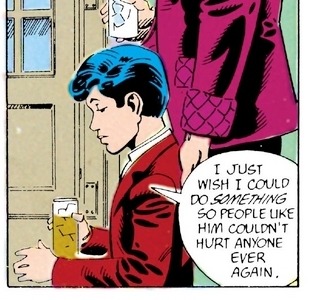
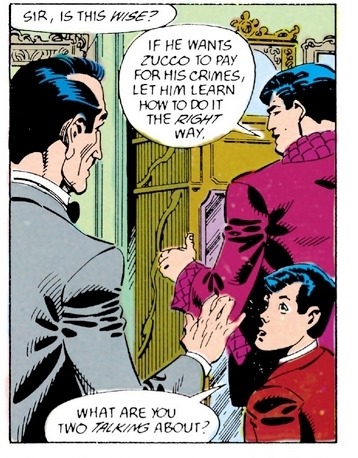
And then there's Jason. Whose backstory has also had a lot of (sometimes major) revisions over the years (remember when his adoption was, like, some kind of Joker-originated long con? Fucken Nu52, man). But the original post-crisis version is pretty straightforward. Steals Batman's tires, gets caught and sent to Ma Gunn's Secret Criminal School, intervenes when Batman goes to investigate, immediately gets offered the chance to be Robin based entirely on that.
Which is itself kind of unhinged. That Bruce saw this kid who was living on his own stealing tires and went "Hey you would make a good Robin" as his very first instinct.
But if you've never read Jason's post-crisis origin, or it's been a while, it's honestly even more unhinged than that because that arc starts with Dick getting "fired" as Robin specifically for the reason that he got shot by Joker and Bruce freaked out about how the Robin identity has too many enemies and therefore Dick, a legal adult with approximately a decade of training and experience, should not use the identity anymore.
(And it's specifically about the Robin identity, in this version, because when Dick says he's not going to stop the crime fighting thing Bruce's response is basically "I know and I didn't expect you to". Honestly I could also say a lot about this version of the Robin/Nightwing transition vs. later ones and how this one definitely feels like the Heavy Hand of DC Editorial in the fact that they had no contact for so long afterwards, because the interaction really doesn't feel like it warrants that in this case compared to some later versions, but that's a whole other too-long ramble.) (Batman (1940) #408)
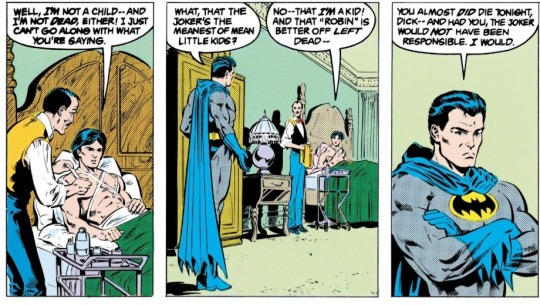
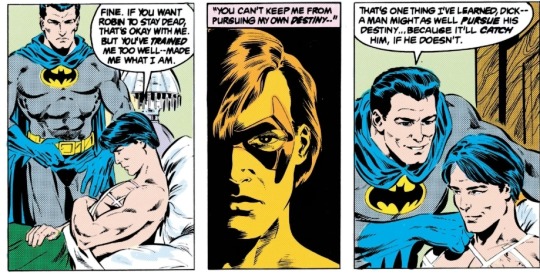
And then a few weeks later Bruce turns around and picks up a random kid, a literal child, and goes "Hey you would make a good Robin!"
And I think a lot about how fucking wild that is. And it's not like the people writing just didn't notice. Dick's big argument with Bruce when he finally comes back to Gotham and meets Jason isn't about the fact that Bruce took in another kid, or even necessarily about Dick feeling proprietary over the Robin identity, the thing he's angry about is that Bruce said it was too dangerous for him, an adult, someone who has trained with Batman for a decade and was already highly physically trained before that for his whole life, to be Robin, and now Bruce has turned around and painted that target onto some random new kid. He pushes, repeatedly, trying to get Bruce to justify himself and this absolutely irresponsible decision, and Bruce gives a lot of answers about how Jason was on a bad path and needed this outlet and eventually just admits that he missed having a partner. (Batman (1940) #416)
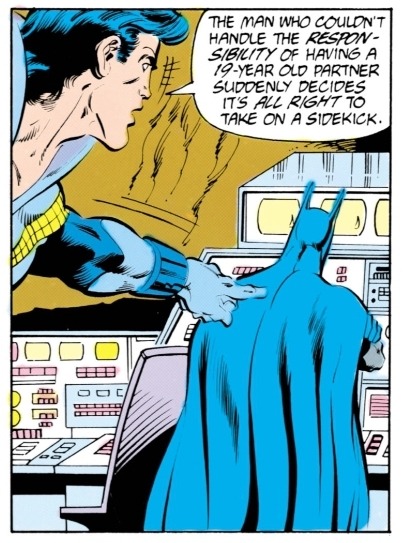
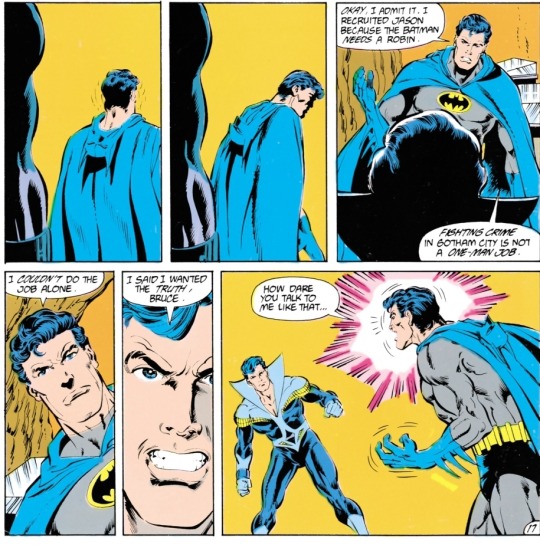
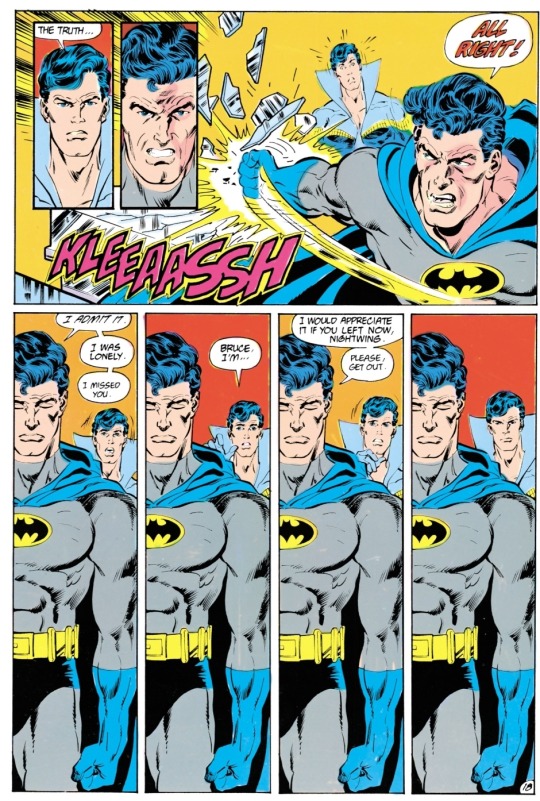
And like. Dick's right, is the thing. He is 1000% in the right in this argument. If he can't be Robin anymore because of the danger, how in the hell is it anything like a good idea to hand it over to someone way younger, way less trained, way less experienced, and expect that that wouldn't end in tragedy?
And then it did.
And yeah, Bruce, it is kinda a lot of your fault.
#And the punchline is Batman clearly should not get to choose his own sidekicks! Haha?#(Sorry this is a lot more serious than my usual Batfam shitposts it won't be a regular habit don't worry)#this is long and rambly but it's something i think about a lot#and it's on my mind extra because of an AU oneshot i'm working on finishing right now#and obviously there's eight kabillion versions of any given origin and reboots and retcons and they change drastically yadda yadda yadda#and also obviously there's always behind-the-scenes editorial choices and other factors when it comes to comics story events#story and character choices are frequently not just a matter of storytelling but of things like meeting editorial demand of What Must Happe#but just looking at the story as presented: the one time bruce specifically recruited someone as his sidekick that kid ended up dead for it#it does make narrative sense given this that bruce's reaction to most of the subsequent kids is initially 'go the fuck home and stop this'#and then only really yielding with the realization that they're totally going to do this shit anyway#jason todd#dick grayson#bruce wayne
114 notes
·
View notes
Text
Frieze New York Bucks Expectations Amid Packed Art World Calendar
Artsy’s team of editors takes you behind the scenes of the best stories in art.
You can find the Artsy Podcast on iTunes, Stitcher, Pocket Casts, or the podcasting app of your choice. Don’t forget to rate the show and leave us comments; we’d love to hear from you.
The sixth edition of Frieze New York opened to VIPs on Thursday with over 200 galleries hailing from 30 countries setting up shop on Randall’s Island through Sunday. Returning from the fair, our editors sat down to bring you the highlights.
The following transcript has been edited for clarity.
Isaac Kaplan: Hello and welcome to The Artsy Podcast, where four editors this week are going to take you around the art world. I’m your host, Isaac Kaplan, joined this week by head of editorial and creative director Marina Cashdan, executive editor Alexander Forbes, and, for the first time, deputy editor Scott Indrisek.
This week we’re going to be talking about Frieze New York, which is happening at Randall’s Island right now. The three editors with me now just got back from the fair. Alex, what’s the rundown on the fair this year?
Alexander Forbes: The sixth edition of Frieze New York opened today at 11 a.m. More than 200 galleries from 31 countries are showing this year. It was a busy morning, and early sales look better than what might have been expected. A number of galleries I spoke with had already sold out their booths. I think a little bit of that is a good amount of pre-selling.
A few things have changed this year. Spotlight, which is a section dedicated to solo art-historical presentations of work created since 1960, expanded to 31 galleries. They’ve also expanded the pseudo-section within the main section of the fair that’s dedicated to galleries showing secondary market or older works. That pulls both from the ongoing trend of diversification of collections and the market as a whole and also taking up some space of galleries that have left the fair and other factors that have shifted the floor plan.
IK: For those that aren’t as familiar with Frieze and its history, Marina, you’ve been going for years now. Can you give us a little bit of background?
Marina Cashdan: Frieze launched in 2003 in London. In 2012, they launched the New York edition and did so in a way that, to me feels very aligned with Frieze the brand. Personally, it’s been one of my favorite fairs to visit because of that intention, the thoughtfulness and airiness, and way in which going to a fair doesn’t feel necessarily like a task or a work necessity but rather something that you create as a full day experience.
It’s on Randall's Island and and it can be a bit of a treck to get there. But the tent, which was designed by SO-IL is bright and airy—it’s a serpentine-like shape—was really designed thinking about how you experience art. It’s a very different experience to going to a convention center. It can also dictate a little bit what dealers show.
IK: What do you mean that the shape of the tent can dictate what’s shown?
MC: Not necessarily the shape of the tent but the whole vibe and aesthetic it creates. It’s very bright. There have been years where you have to wear sunglasses indoors because it is so bright. There is a lot more space for galleries. Many galleries have followed that design, giving galleries more space around and above their booths. You get a feeling that you’re in a gallery space, a white cube, but this is a tent on an island. It sounds very dreamy. Though it’s not always so dreamy getting there depending on the weather. But it is a fair, in my opinion, where you can enjoy looking at work.
AF: I think last year it was really windy and the tent sounded like it might fall over any minute. But, to your point about how it can push a certain aesthetic or look on things, I think it comes from their editorial background. There is a very “Frieze” look to art that gets shown at Frieze. There’s a healthy debate in the art world about whether that’s a good thing, whether or not fairs should be more merchandising-oriented or should be more curatorial. Frieze is definitely heavy on the curatorial approach. So, there tends to be a lot of light wood, handcrafted work, light colors, pastels, much more white work than you might see other places. It’s very funny in that way. But there is a very Frieze aesthetic to the work you see there.
MC: In the same way, too, that there’s often a very Miami aesthetic to the work you see at Art Basel in Miami Beach. But that’s less associated with the design of the space and more the clientele or collectors who are visiting.
Scott Indrisek: Do you think that’s imposed from the top down? When Frieze itself is thinking about who they want to allow in? Or is it galleries knowing what’s going to work in that space?
AF: From my understanding, the directors do oftentimes go into galleries and ask them to bring a certain artist or a group of works that they want to have at the fairs. So there is this little bit more directional approach. It works phenomenally well from a visitor experience perspective. One of the criticisms that’s been levied against Frieze by some is that it creates a less market-oriented market event. So as people are looking at fairs with a little more criticality as to what they want to participate in, particularly in a jampacked year like this year, I think there’s been a little more criticality around that.
The Venice Biennale is coming up next week. Many different art events have happened over the last month across Europe. I was in Berlin over the weekend last weekend for Gallery Weekend Berlin, and a lot of people said they just couldn’t justify making the trip this year. That was a worry going into Frieze Week. It doesn’t seem to have panned out.
I was talking to someone at Mendes Wood and they had nearly sold out the booth. David Kordansky Gallery sold out their entire booth including paintings by Tala Madani. Hauser & Wirth had nearly sold out their booth of works by Lorna Simpson, who they just started representing. So, all told, a seemingly good start. We’ll see as the rest of the fair goes on. It has to happen on opening day or it doesn’t happen at all at Frieze New York because people don’t tend to come back again. But I guess those worries are relatively unwarranted at this point.
IK: You mentioned that there’s a super crowded art world calendar right now. The auctions also moved their dates this year. Has that had any effect on Frieze?
AF: It’s hard to say so far. I know in the past, dealers have said that the auctions did bring in particularly clients from Asia that might have not otherwise been there. It did seem like more of a European and American crowd there today than has necessarily been the case there in the last two years. I didn’t see as strong of a presence from Asia. And I know a couple of major collectors from Shanghai that I saw last week in Europe weren’t coming to Frieze. Will that matter for results on the whole? It could mean that a few galleries have a few less massive sales. But, in general, the price level of the work at Frieze New York is not like at Art Basel in Basel. So the amount that one or two collectors or even 10 collectors from Asia can make can be significant, but I don’t think it’s going to swing things drastically one way or another.
IK: And it’s not going to have an impact on the auctions? Does Frieze bring in collectors that would otherwise not be here for the auctions? Or, if someone is going to bid, are they still going to bid?
AF: Yeah, it’s hard to say if they’ll travel. But, obviously, there are ways to bid remotely, including Artsy.
IK: Good plug. In terms of highlights of the fair, Scott, you came into the recording room with a thing full of pills. Not to narc on you, but that’s part of an artwork. What happened there?
SI: It was from the booth of Esther Schipper, and it was from a performance by Roman Ondak. It’s called The Swap, and it’s happened a few times before; they have a number of different people who take shifts sitting at a desk. They start out with one object and they trade it. When I came in first thing in the morning, a small pen was the first object, and I had nothing to trade other than a partially used Chapstick. They weren’t too excited about that. I came back a little bit later because another colleague of ours, Casey [Lesser], said that at one point in time, €50 was on the table, ready to be exchanged.
AF: I heard someone exchanged $20 for it.
SI: Artists are very bad at math. So when I came back, it was this pill box. Evidently, the person who had given it in was a collector of Ondak’s and didn’t want their medication any more.
IK: It’s a little concerning if you think too much about it.
SI: Yeah, we’re still doing some research about what this is. But I traded a Mary Gaitskill novel that now I kind of regret trading in because it was really good. But I can buy it again. And now I have some unidentified medication in the name of art. They seemed a little concerned about the whole thing. I think they were happy for someone to take it. Well, not take it—but out of the project.
IK: Tune in to the next podcast to see if Scott is still alive. But, Marina, what caught your eye?
MC: One of the allures for me of Frieze New York are the Frieze Projects, which are curated by Cecilia Alemani, who is also the director and chief curator of the High Line. There was a man wearing pelts and we think, but still haven’t confirmed this, that it’s part of Dora Budor’s work sort of redubbing scenes from cinema. So, we think this was from The Revenant and there were various Leonardo DiCaprio characters from various films that were roaming through the fair.
Another project will rotate through the week; it’s a restaging of a project from Galleria La Tartaruga, an experimental gallery that was active in the 1950s. She’s restaging two of the projects that were part of that exhibition and then two contemporary artists. So today it was Giosetta Fioroni. You basically go into what looks like an empty booth but within it is a spyhole. And through the spyhole there’s a room and you see a woman, seemingly in her private room. And you watch her in this bedroom setting through this convex peephole. It feels a little odd to be doing this in an art fair. But that’s part of the beauty of some of these projects.
Cecilia, in my eye, has done a really great job in these projects in restaging historical works and making it really accessible to a contemporary audience. Last year, she did something from the Daniel Newburg Gallery. One of my favorites was from 2013 when she restaged Food, the Soho artist-run restaurant. But there are also going to be two contemporary artists as well. I know, Scott, you visited one.
SI: Yeah, I visited Adam Pendleton’s studio earlier in the week. The show that she’s alluding to was from 1968 and was called Teatro della Mostre and the whole conceit of it is that each artist got one day to do something. So Adam Pendleton on Saturday is staging a performance; it’s taking place four times and it’s got an opera singer, two gospel singers, a string quartet, and an environment where he’s sampled bits of Malcolm X’s 1964 speech “The Ballot or the Bullet,” which is really worth rereading. I read it at some point in time but it’s really, shockingly relevant, which is I’m sure why he’s revisiting it now. It seems like a very fly by night, improvisational performance. When I spoke to him, the whole group hadn’t rehearsed together in one place. They’re going to be sitting down in the booth on Saturday and winging it to some degree.
MC: It’s a good segue into another work: Anri Sala at Marian Goodman. Marian Goodman tends to bring very thoughtful, showstopping (but not in a spectacle way) booth. And Anri Sala created a work that’s been seen before in various forms but this is now taking it into sculpture. And it takes 74 song bridges and making a composition out of those song bridges. That would normally feel very disjointed but they end up becoming quite a beautiful, full piece. You see the various components of this piece come together, but the work is these various drums hanging from the ceiling. It’s very minimal but you have the drumsticks moving, and you put on the headphones and it really took me away from the bustle of the fair.
AF: That’s one of the things that Frieze New York does particularly well and is fairly unique about it. You do get many of these solo presentations even among the major galleries that have massive booths. Most of the time you see those in the younger sections of fairs. But, whereas maybe at one of the Art Basel fairs, galleries can’t afford to not have a selection or a major piece by every artist that they represent, because Frieze New York isn’t known as a sales powerhouse but potentially better as a marketing opportunity, you have people like Gagosian this year which is showing a solo booth of all smaller booths by John Currin; I couldn’t begin to count how many works are in there, but it’s pretty impressive.
SI: Yeah, probably 100 I would say.
AF: It’s the second year they’ve done that as well. Last year, welcoming back Damien Hirst to the program—I don’t know if that was officially part of the contract to get him back—and now with John Currin who is an artist that hasn’t really been present for the past five or six years, to see that work again was really fun.
MC: It was really fun. The works are drawings—we’re so used to seeing his paintings—but they’re a little more playful. And there’s a little more weirdness. He’s known for that, in his inflations of various body parts.
SI: These almost reminded me of Playboy cartoons from the ’60s or something.
AF: Which are one of his main reference materials, I think.
MC: I would have never related Currin’s work to R. Crumb but there was a little of that comic, playful aspect that around the corner at David Nolan’s booth you saw in R. Crumb. They were literally talking to each other. Making those kind of connections at art fairs is one of the pleasant surprises that you encounter. Another highlight for me was the Kiki Kogelnik booth. It was a solo booth and was just chock-full of works by what I would call a proto-pop artist, an Austrian artist who lived in New York for a while and is very well known for her figurative work, which she was referencing a lot of fashion magazines but was incorporating a lot of bold florals and stripes. But she was also referencing a lot of feminism and technology in her work. I could probably stand in that booth and absorb it for longer than I was able to.
AF: She was so ahead of her time. She passed away in 1997 and has really come to the fore in the past few years.
SI: The one booth that really surprised me was in the Spotlight section, was Honor Fraser Gallery’s Kenny Scharf booth. Kenny Scharf is an artist that, I think, just because he’s so ubiquitous, and kind of silly and playful, there are so many murals of his around, you’re just so used to seeing them. But these are early works of his from the late ’70s and early ’80s. He was involved in an East Village club called Club 57, which is also going to be the subject of an exhibition at MoMA that he’ll be a part of. You could still tell that it was still his characters but there was a whole set of really crazy boomboxes that he had painted over and adorned and I guess he also did that on a commission basis in the late ‘70s and early ‘80s; he would take out ads in the Village Voice and you could have Kenny Scharf bedazzle your boombox.
IK: There’s also a whole history that I think that MoMA show is going to begin to uncover that’s clubs in New York City in this time period being really important venues for performance and for art in ways that they’re sort of aren’t any more today. Everyone knows Warhol, but there’s much more to that story.
SI: I was about two years old, so I was not deeply involved in the scene. Another booth that I really liked, though, was CANADA Gallery’s booth. They’re really trying to rebel against their booth looking like a booth. One year they had Katherine Bernhardt curate the booth. She has a sideline career selling Moroccan rugs, so the whole booth was full of rugs and very homey. This year their artist Marc Hundley curated the booth, and it’s even more domestically scaled. They made the booth look, essentially, like his apartment. There’s a table in the back that’s even, I think, his kitchen table. They’ve also hung a lot of work that’s not necessarily for sale, and a lot of the work isn’t necessarily CANADA artists. And there’s a daybed there that you could sleep on, I guess, if you were really tired.
I also really liked, at Xavier Hufkens’s booth, there was almost a mini solo show of David Altmejd busts. I had seen them before but these ones were almost creepily lifelike. Sometimes his sculptures will have these eyes that look like, almost, fake costume eyes. But these looked creepily real. There was a kind of zombie Abe Lincoln.
MC: And in these pastel colors. You are drawn to them. They aren’t creepy in that they’re so lifelike that you think it’s a head on a pedestal.
AF: They also really reminded me of some of what he was doing a little earlier on. He had this show at the Musée d’Art Moderne a few years ago in Paris and he kind of threw everything it that he could in terms of the weirdness and craziness of the work. And these were a little bit more reserved, which was nice to see him return to that. And also nice to see him have a strong showing in New York now that his main gallery in New York, Andrea Rosen, is coming to a close.
IK: There’s a ton of stuff happening in the city this week for Frieze. Where are you guys going to be drinking white wine in the art world this week? Scott, because you’re new, we’re going to start with you.
SI: Well, a show that I recently saw, that just opened and I would return to again was Verne Dawson at Gavin Brown. The show is called “Tinnitus.” I’m not sure why; I walked in and kind of expected something loud and kind of death metal-based. But they’re really these funky weird paintings, some landscapes. I really recommend it. They’re also showing a couple of his works at Frieze if you want to get a teaser and then see more.
IK: Alex, where are you going to be headed to?
AF: I’m going to head to the New Museum to see the Carol Rama show. She’s an Italian artist who passed away in 2015, and has been uncovered over the past few years. She showed mostly in Italy in her hometown of Turin. Galerie Isabella Bortolozzi stepped in and really brought the work to a new level of visibility; she’s now also represented by Lévy Gorvy. But it’s just incredibly fun work. She had such a varied career. I highly recommend the work and and super psyched to see what the New Museum did with it, to see this much more institutional-scale exhibition rather than just a gallery show or fair booth.
IK: And, Marina?
MC: I’m planning on going to 1:54, which is an art fair that’s dedicated to contemporary African art. It’s located in an amazing space called Pioneer Works in Red Hook, Brooklyn. There are also some projects that they do alongside the fair. This is the third edition of the fair, but this year they also have a show on Malick Sidibé, who recently passed away, and that’s at the Red Hook Labs.
IK: And I am going to be going to Elizabeth Dee gallery to see a show called “With the Eyes of Others,” which is an exhibition on Hungarian artists in the ’60s and ’70s who were forced to work under very repressive regimes. And it’s a very broad survey of the politically charged work that they created. And I’m excited to check it out because I’ve never been to Elizabeth Dee since it opened in Harlem, so it’s been on my bucket list for a very, very long time.
This podcast is hosted by Artsy Associate Editor Isaac Kaplan, joined for this edition by Head of Editorial and Creative Director Marina Cashdan, Executive Editor Alexander Forbes, and Deputy Editor Scott Indrisek. It was produced by Editorial Associate Abigail Cain.
Intro music: “Something Elated” by Broke For Free
Cover image: Photo by Mark Blower, courtesy of Frieze.
from Artsy News
0 notes